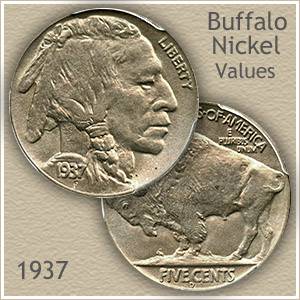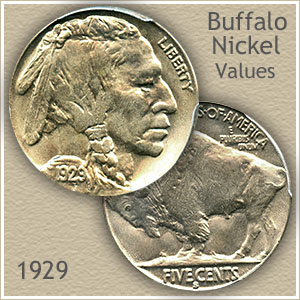1937 Indian Head Nickel
Coin Values Moving with Precious Metals: Up-Dated 2/8/2021: Gold $1813 Silver $26.90
Apr 11, 2020 A nickel from this year in poor or heavily used condition would be worth about $1.75, but if the coin is in near-mint or perfect condition, the value is as high as $45. The price can go anywhere between these figures, depending on its actual condition. 17,828,000 of these buffalo nickels were produced in 1937. Indian Head (Buffalo) 5 Cents 'Buffalo nickel' most American coin By Paul Gilkes. The 1937-D Three-Legged Bison coin resulted from a Mint technician overpolishing a reverse die, taking away a. The Buffalo nickel population received a certain shot in the arm in 1937, as more than 100 million Buffalo nickels were made that year – a high number indeed, but not nearly as astronomical as the 150 million-plus of 1936. Philadelphia struck 79,480,000 Buffalo nickels in 1937, while Denver provided 17,826,000 and San Francisco produced.
Today the 1937 nickel value begins at $.50 cents each. The price is for a heavily worn coin, in what is known as 'Good' condition.
However, the 1937 nickel is famous because of an interesting and rare variety where the buffalo has only three legs. Find below a description and close up view to help identify this valuable coin.
The 1937-D Buffalo Nickel. These 1937-D Indian Head Nickel U.S. Coins are For Sale with Low Prices. Find Rare Coins including the Buffalo Nickle and many other old coins here.
Two more important elements change how much your buffalo nickel is worth. First mintmarks, they indicate the mint that produced the coin and are valued separately.
Secondly, consider the condition of your coins. The 'Uncirculated' 1937 nickel pictured is highly prized by rare coin dealers and collectors because of condition. Huge swings in value follow the better condition coins.
1937 Indian Head Nickel Value
An exciting year with many variables, such as date, mintmarks and the elusive 3 Legged variety contributing to 1937 nickel value.
The chart separates values according Condition and the Mints that produced the coin.
A listing of '1937-D' is a coin minted in Denver, they used a 'D' as a mark.
An 'S' is the mintmark used by the San Francisco mint. These two mints placed their mintmark on the reverse below the buffalo. The third mint to strike Buffalo nickels, Philadelphia, did not use a mintmark.
| 1937 Nickel Value | ||||
|---|---|---|---|---|
| Condition of Coin | ||||
| Date | Good | Fine | Extremely Fine | Uncirculated |
| 1937 Nickel Value Updated | 2021 | |||
| 1937 | $0.51 | $1.05 | $2.44 | $19 |
| 1937 D | $0.51 | $1.03 | $2.82 | $20 |
| 1937 D 3 Leg | $232 | $270 | $428 | $1,107 |
| 1937 S | $0.51 | $1.27 | $3.41 | $18 |
Finding the 1937-D 3 Legged Buffalo Nickel
Notice the right front leg of the buffalo is missing!
A very distinctive mint made error once you have seen it, the 3 Legged Buffalo variety is popular with collectors and considered necessary to complete a collection. These are two powerful forces driving the value of the 1937-D 3 Leg Buffalo nickel.
The 3 Legged variety is found on nickels minted at the Denver mint. Locate the 'D' mintmark, identifying the mint, below the buffalo under the 'Five Cents.'Excessive die polishing is believed as the reason too much metal was removed causing the buffalo's leg to vanish. Before the mint realized the error a few thousand had been released into circulation.
Back in the day many of these now valuable nickels circulated freely, the result is 3 legged buffalo nickels are found today showing all degrees of wear. They can turn up in any box of old coins.
In the later years of the buffalo nickel series greater numbers of coins were saved, both from circulation and new from the banks. With many to choose from and many in better condition, collectors favor the high grade buffalos. It takes a very nice coin to break away from being worth a dollar.
Condition Determines 1937 Nickel Value
Uncirculated: A 1937 buffalo nickel in this condition stands out as a superior coin. It never circulated, therefore its surfaces show no signs of wear. Handle coins in Uncirculated condition by their edges to preserve their surfaces. Rotate the coin under a light, examine the cheek of the Indian and upper back of the buffalo for signs of wear, appearing as dullness on the high spots.
Extremely Fine: This coin shows evidence of use but was collected from circulation before to much wear took place. A nice looking coin with abundant detail, although the hair braid is reduced and shows some loss of detail, and on the reverse the small details along the buffalo's back have begun to wear.
Fine: Additional wear has reduced the major details and eliminated the finer points of design. Obvious loss of sharpness and an overall smoothness is evident on the entire surface of the coin.
Good: The date is readable, however parts of the numbers are often merged. The rim is no longer separated from the tops of the letters. The roundness of the design to the buffalo has become flat on the hip, stomach, shoulder and head. This coin is at the low side of 1937 nickel value.
Coin Values CoinStudy Articles

Date by Date
In Depth Buffalo Nickel Value
1913 to 1938
1913 | 1919 | 1926 | 1934 |
1914 | 1920 | 1927 | 1935 |
1915 | 1921 | 1928 | 1936 |
1916 | 1923 | 1929 | 1937 |
1917 | 1924 | 1930 | 1938 |
1918 | 1925 | 1931 |
Check all your buffalo nickel values with the coin value chart and separate the common from the rare. Rising prices, increasing demand from both collectors and rare coin dealers requires a second look at your coins.
:max_bytes(150000):strip_icc()/US0005-Buffalo-Nickel-No-Date-56a179685f9b58b7d0bfa63e.jpg)
Including more relating to your 1937 nickel value. These early Buffalo nickels are becoming valuable. Easily find how much your old coins are worth.
Covering the Nickel series from Shield nickels, Liberty, Buffalo and Jefferson nickels. All include value charts, along side grading images to find the accurate value of your old nickels.
★Coin Values Discovery... finds 1937 nickel value and...
all old US coin values. It links to coin series, from Cents to Gold. Value charts, images to judge the all important condition of coins, and a guide to getting the best deal if selling coins.
Finding Rare Nickels!
On occasion rare nickels do turn up... old better date buffalo nickels, valuable silver war nickels, even a few Jefferson nickels and others. Search your box of old coins and discover the possibilities of... Finding Rare Nickels
1937 Indian Head Nickel Three Legged
Indian Head (Buffalo) 5 Cents
'Buffalo nickel' most American coin By Paul Gilkes
COIN WORLD Staff Renowned sculptor James Earle Fraser was fascinated by the American Indian, so much so that it was no surprise he chose an Indian motif for the 5-cent c...READ MORE
Indian Head (Buffalo) 5 Cents
1937 Indian Head Nickel Worth
'Buffalo nickel' most American coin By Paul Gilkes
By Paul GilkesCOIN WORLD Staff Renowned sculptor James Earle Fraser was fascinated by the American Indian, so much so that it was no surprise he chose an Indian motif for the 5-cent coin design. And the bison design for the reverse made a perfect companion image. It is arguably the most 'American' of all United States coins and is a collector favorite. Fraser's artistic prowess earned the undying respect of a dying Augustus Saint-Gaudens, who recommended Fraser to President Theodore Roosevelt to sculpture the official presidential bust. Roosevelt and Fraser became quick friends. Despite the fact that William Howard Taft was president in 1912, it was Roosevelt who recommended that Fraser be chosen to design the copper-nickel 5-cent coin, overdue by five years for a design change. In the early 20th century, coin designs were usually changed every 25 years automatically. The obverse design for the Indian Head 5-cent coin, commonly called the 'Buffalo nickel,' depicts a large, powerful portrait of an Indian, facing right. The appearance is rough-hewn, unlike the smooth cheeks and other facial features that characterize innumerable Liberty renditions. The portrait is purported to be a composite of three Indians, although the identities of the models have been disputed. A few Native Americans laid claim to be the model for the coin. Frazer identified the models as Iron Tail, a Sioux; Big Tree, a Kiowa; and Two Moons, a Cheyenne. All three visited Roosevelt while in New York City, according to Fraser, who studied and photographed them during their stay. Fraser's designer initial, F, appears incuse below the date on the obverse. More is known about the American bison that served as the model for the reverse design. It was Black Diamond, an inhabitant of the New York Zoological Park. Fraser employed a little artistic license to portray the bison as though he were living free on the Great Plains. The stuffed head of Black Diamond was displayed at a major coin convention during the 1980s. During the inaugural 1913 year, two distinct subtypes were produced at the Philadelphia, Denver and San Francisco Mints: the Bison on Mound and the Bison on Plain. Because of the fear that the FIVE CENTS denomination legend on the reverse would wear off quickly in circulation, Chief Engraver Charles E. Barber modified the reverse hub. Barber placed FIVE CENTS within an exergue to protect it from excessive wear, reducing the mound to level ground. Barber also smoothed down the roughened fields that gave the coin its distinctive look. Among the challenging dates to find are the 1916 Doubled Die, of which approximately 100 pieces in all grades are believed to exist. The 1918/7-D coin was created during a die shortage when a 1917 working die was impressed with that of a hub dated 1918. The 1937-D Three-Legged Bison coin resulted from a Mint technician overpolishing a reverse die, taking away a portion of one of the two forelegs. The Indian Head 5-cent coin is a popular series with collectors. High-quality collections offered for sale at coin shows are quickly gobbled up to meet market demand. After its legislated 25-year run, the Indian Head 5-cent coin was replaced in 1938 by a new design depicting the third president of the United States, Thomas Jefferson.
Indian Head 5 cents | |
| Date of authorization: | May 16, 1866 |
| Dates of issue: | 1913-1938 |
| Designer: | James Earle Fraser |
| Engraver: | Charles Barber |
| Diameter: | 21.21 mm/0.84 inch |
| Weight: | 5.00 grams/0.16 ounce |
| Metallic content: | 75% copper, 25% nickel |
| Edge: | Plain |
| Mint mark: | Reverse below FIVE CENTS |